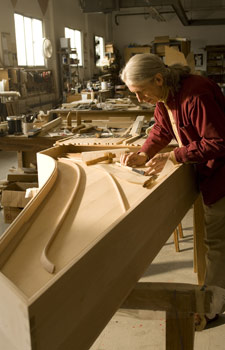
Hubbard
Harpsichords, Inc. has always been first and foremost a maker of fine
finished keyboard instruments – kits represent only a part of
our activity. During the fledgling years of the Hubbard workshop,
Frank Hubbard's friends would sometimes drop by to observe the instruments
under construction; some would stay on to dabble or build. (Image: R. K. Lee watches Frank Hubbard adjust a key; Photo: Christopher Bannister)
Gradually,
as the workshop took on the aura of hobby heaven, the concept of the
kit harpsichord was born. The immediate result was an acoustically
successful design that included a first-rate package of materials and
instructions capable of meeting with success in unpredictable situations.
Such a thing could never have been devised if Frank Hubbard had
not already been making first-quality harpsichords.
It
wasn't too many years before the number of playing Hubbard kits exceeded
the number of instruments finished in-shop. Ironically, in the
public mind it was these kits that became the face of Hubbard, not the
series of particularly fine productions that continued quietly to issue
forth from the Hubbard workshop in a series unbroken since Frank Hubbard
and William Dowd set up their separate companies. At the time
of Frank Hubbard's death in 1976 it had already become clear to Diane
Hubbard that the knowledge gained by making finished instruments is
absolutely central to each of the company's other facets – the
sine qua non. Consequently, the production of custom
instruments was carried on. In 1979 I was invited by Diane to
return to the firm as Technical Director. Since 1982 all finished
instruments have been issued from the shop under the name Hubbard &
Broekman.
So,
who was this upstart, Broekman? While still a music student,
I had started my training in harpsichord making in 1965 at the Cannon
Guild under Eric Herz. For the rest of the '60's, I continued
to work for Eric as my time and studies allowed. Back in New
York for lessons and course work, I supported myself as a professional
harpsichord tuner and technician. In this endeavor I was able
to put to good use much of what I had learned in Boston, for it was
at Herz's shop that I learned the basic principles and desiderata governing
harpsichord actions. Eric insisted that actions be reliable and
work – neither rocket science nor a gimmee but subtle work that
demands care and consideration. Finally, in 1969 I decided to
take up harpsichord making full-time. Eric, however, ran a ruthlessly
efficient, bare-bones shop in which there was not much scope for me
to become meaningfully involved in either design or instrument assembly.
I started at Hubbard in 1970 with the purpose of learning those
aspects of the craft.
Frank Hubbard occupied the opposite end
of the continuum from Eric. By that time Frank had populated
his shop with one professional cabinetmaker and an enthusiastic collection
of neophyte makers and maker-wannabes, many of whom displayed various
florid, (but mercifully temporary) symptoms of 'neat-thing' syndrome.
Our master had real problems using the simple declarative, "No".
He seemed to be of several minds regarding his place at the center
of all the resulting fuss and kerfuffle, but showed genuine delight
when he caught a whiff of fresh clarity in some acolyte's thinking.
It was the best of places, it was the worst of places.
In 1972, after two intense years I left and, newly married, opened my
own shop in Lebanon, NH, later moving across the river to Norwich, VT.
These years, my time in the wilderness, were an opportunity to
wrestle with the craft, gain insight and amass confidence.

For
me, the custom instruments we produce continue to be a constant source
of deep personal pride. While I am responsible for all work that
goes out the door of our small shop (kits, repairs, new construction,
etc.) I can't do it all. I am forced to choose what work needs
my first-hand attention. Although much gets delegated, this is
least the case when it comes to our custom instruments. Even if, to
begin with, I haven't built it from the ground up, I set up the action.
I came to the trade as a player and now, over forty years later,
steeped in the maker's art, a player I remain. Whatever else
the case, no instrument leaves the shop without pleasing me.
If I can't sit down at an instrument and play with delight for an hour
at the end of the day, it's not ready. (Above: Hendrik Broekman in the Framingham shop; Photo: John Burke)
The
descriptions contained in the offering sheets for our custom instruments
(available as .pdf downloads from the links on the pages that follow) have been written
both to outline the histories and contexts of each type as well as to
answer the most usual practical queries. If you have any further
questions, I would be delighted to answer them. Please feel free
to contact me at finfo@hubharp.com.
Offering
Sheets (Descriptions, Specifications & Prices)
Available From Pages Below
Flemish single-manual harpsichords*
of the 16th, 17th & 18th centuries
Flemish virginals*
of the 16th & 17th centuries 'Mother & Child'
Flemish double-manual harpsichords
of the 17th century à grand ravalement
Flemish double-manual harpsichord
of the 18th century
French double-manual harpsichords*
of the 17th & 18th centuries
English bentside spinet*
of the 18th century
German double-manual harpsichords
of the 18th century
German unfretted clavichord
of the 18th century
Italian single-manual harpsichords
of the 17th & 18th centuries
*Indicates SOME models are
also available as kits.